
George Rogers Clark was an American military officer and surveyor from Virginia who became the highest-ranking Patriot military officer on the northwestern frontier during the Revolutionary War. He served as leader of the Virginia militia in Kentucky throughout much of the war. He is best known for his captures of Kaskaskia in 1778 and Vincennes in 1779 during the Illinois campaign, which greatly weakened British influence in the Northwest Territory and earned Clark the nickname of "Conqueror of the Old Northwest". The British ceded the entire Northwest Territory to the United States in the 1783 Treaty of Paris.
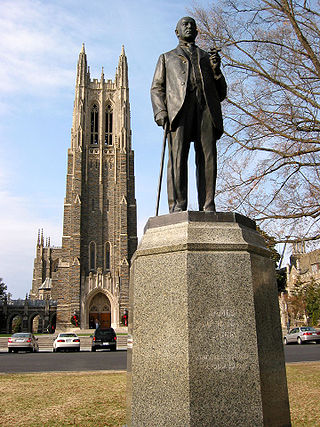
Charles Keck was an American sculptor from New York City, New York.

Monument Avenue is a tree-lined grassy mall dividing the eastbound and westbound traffic in Richmond, Virginia, originally named for its emblematic complex of structures honoring those who fought for the Confederacy during the American Civil War. Between 1900 and 1925, Monument Avenue greatly expanded with architecturally significant houses, churches, and apartment buildings. Four of the bronze statues representing J. E. B. Stuart, Stonewall Jackson, Jefferson Davis and Matthew Fontaine Maury were removed from their memorial pedestals amidst civil unrest in July 2020. The Robert E. Lee monument was handled differently as it was owned by the Commonwealth, in contrast with the other monuments which were owned by the city. Dedicated in 1890, it was removed on September 8, 2021. All these monuments, including their pedestals, have now been removed completely from the Avenue. The last remaining statue on Monument Avenue is the Arthur Ashe Monument, memorializing the African-American tennis champion, dedicated in 1996.
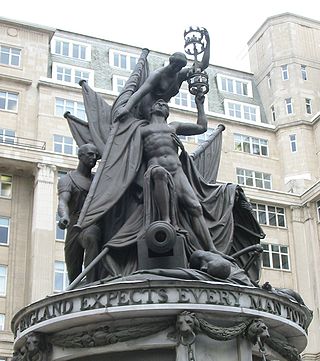
The Nelson Monument is a monument to Admiral Horatio Nelson, in Exchange Flags, Liverpool, England. It was designed by Matthew Cotes Wyatt and sculpted by Richard Westmacott. It stands to the north of the Town Hall and was unveiled in 1813.

Henry Merwin Shrady was an American sculptor, best known for the Ulysses S. Grant Memorial on the west front of the United States Capitol in Washington, D.C.
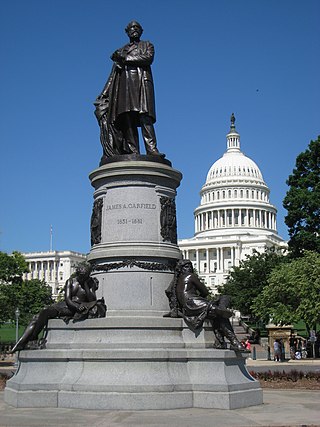
The James A. Garfield Monument stands on the grounds of the United States Capitol in the traffic circle at First Street and Maryland Avenue SW in Washington, D.C. It is a memorial to U.S. President James A. Garfield, who was elected in 1880 and assassinated in 1881 after serving only four months of his term. The perpetrator was an attorney and disgruntled office-seeker named Charles J. Guiteau. Garfield lived for several weeks after the shooting, but eventually succumbed to his injuries. The monument is part of a three-part sculptural group near the Capitol Reflecting Pool, including the Peace Monument and the Ulysses S. Grant Memorial in Union Square. The monument is also a contributing property to the National Mall and L'Enfant Plan, both of which are listed on the National Register of Historic Places and the District of Columbia Inventory of Historic Sites. The bronze statue rests on a granite pedestal that features three sculptures, each one representing a time period in Garfield's life.

Stephen Foster is a landmark public sculpture in bronze by Giuseppe Moretti formerly located on Schenley Plaza in the Oakland section of Pittsburgh, Pennsylvania. Formerly sited along Forbes Avenue near the entrance of Carnegie Museum of Natural History, in the shadow of Dippy, a life-size sculpture of a Diplodocus dinosaur, and in close proximity to the University of Pittsburgh's Stephen Foster Memorial, the Foster statue is one of the city's best known and most controversial. It was removed on April 26, 2018 on the unanimous vote of the Pittsburgh Art Commission.

The Confederate Monument in Owensboro, Ky., was a 16-foot-tall, two-part object — a 7-foot-tall bronze sculpture atop a 9-foot-tall granite pedestal — located at the southwest corner of the Daviess County Courthouse lawn, at the intersection of Third and Frederica Streets, in Owensboro, Kentucky. Nearly 122 years after the monument was dedicated in September 1900, the monument was dismantled in 2022, beginning with the removal of the sculpture in May 2022; the sculpture was placed in storage, pending a decision on what to do with it.
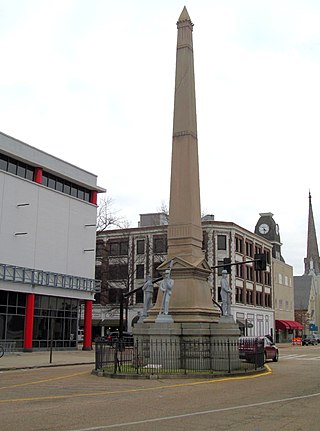
The Confederate Monument in Portsmouth, Virginia, was built between 1876 and 1881. It was listed on the National Register of Historic Places (NRHP) in 1997.

Lieutenant General George Washington is an 1860 equestrian statue of George Washington, at Washington Circle, at the edge of the George Washington University's campus, in Washington, D.C. The statue was sculpted by Clark Mills, who also created the equestrian statue of Andrew Jackson in front of the White House. The traffic circle where the statue is located was one of the original city designs by Pierre Charles L'Enfant. The statue and surrounding park are in the Foggy Bottom neighborhood at the intersection of 23rd Street, New Hampshire Avenue, and Pennsylvania Avenue NW. The K Street NW underpass runs beneath the circle.

Major General George Henry Thomas, also known as the Thomas Circle Monument, is an equestrian sculpture in Washington, D.C. that honors Civil War general George Henry Thomas. The monument is located in the center of Thomas Circle, on the border of the downtown and Logan Circle neighborhoods. It was sculpted by John Quincy Adams Ward, best known for his work on the statue of George Washington in Wall Street, Manhattan. Attendees at the dedication in 1879 included President Rutherford B. Hayes, Generals Irvin McDowell, Philip Sheridan, and William Tecumseh Sherman, senators and thousands of soldiers.
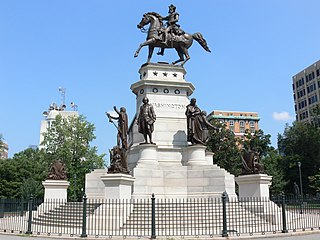
The Virginia Washington Monument, known locally simply as the Washington Monument, is a 19th-century neoclassical statue of George Washington located on the public square in Richmond, Virginia. It was designed by Thomas Crawford (1814-1857) and completed under the supervision of Randolph Rogers (1825-1892) after Crawford's death. It is the terminus for Grace Street. The cornerstone of the monument was laid in 1850 and it became the second equestrian statue of Washington to be unveiled in the United States. It was not completed until 1869.

The statue of John Aaron Rawlins, a United States Army general who served during the Civil War and later as Secretary of War, is a focal point of Rawlins Park, a small public park in Washington, D.C.'s Foggy Bottom neighborhood. It was installed in 1874, but relocated several times between 1880 and 1931. The statue was sculpted by French-American artist Joseph A. Bailly, whose best known work is the statue of George Washington in front of Independence Hall in Philadelphia.

The Virginia Monument, also commonly referred to as "The State of Virginia Monument", is a Battle of Gettysburg memorial to the commonwealth's "Sons at Gettysburg" with a bronze statue of Robert E. Lee on his horse Traveller and a "bronze group of figures representing the Artillery, Infantry, and Cavalry of the Confederate Army". The equestrian statue is atop a granite pedestal and the group of six standing figures is on a sculpted bronze base with the figures facing the Field of Pickett's Charge and the equestrian statue of Union General George G. Meade on Cemetery Ridge. The granite pedestal without either sculpture was dedicated on June 30, 1913 for the 1913 Gettysburg reunion. On June 8, 1917, Virginia governor Henry C. Stuart presented the completed memorial to the public.
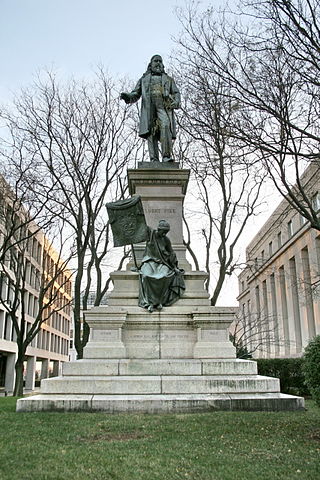
The Albert Pike Memorial is a public artwork in Washington, D.C., erected in 1901, and partially demolished in 2020 by protestors responding to the murder of George Floyd. It honors Albert Pike (1809–1891), a senior officer of the Confederate States Army as well as a poet, lawyer, and influential figure in the Scottish Rite of freemasonry. The memorial—which now only includes the base and Goddess of Masonry sculpture—sits near the corner of 3rd and D Streets NW in the Judiciary Square neighborhood. The memorial's two bronze figures were sculpted by Gaetano Trentanove, the Italian-American sculptor of another Washington, D.C., sculptural landmark, the Daniel Webster Memorial. The dedication ceremony in 1901 was attended by thousands of Masons who marched in a celebratory parade.

Thomas Jonathan Jackson is a historic bronze equestrian statue of Confederate general Stonewall Jackson which was formerly located at Courthouse Historic District of Charlottesville, Virginia and installed in 1921. The statue was sculpted by Charles Keck and was the third of four works commissioned from members of the National Sculpture Society by philanthropist Paul Goodloe McIntire. It was the second of three statues McIntire donated to the city of Charlottesville, which he did over a period of five years from 1919 to 1924. The statue was listed on the National Register of Historic Places in 1997.

The Robert E. Lee Monument was an outdoor bronze equestrian statue of Confederate general Robert E. Lee and his horse Traveller located in Charlottesville, Virginia's Market Street Park in the Charlottesville and Albemarle County Courthouse Historic District. The statue was commissioned in 1917 and dedicated in 1924, and in 1997 was listed on the National Register of Historic Places. It was removed on July 10, 2021, and melted down in 2023.

Meriwether Lewis and William Clark was a historic bronze sculpture of Meriwether Lewis, William Clark, and Sacagawea located at Charlottesville, Virginia. Known as Their First View of the Pacific, it was sculpted by noted artist Charles Keck (1875-1951), and was the first of four commemorative sculptures commissioned from members of the National Sculpture Society by philanthropist Paul Goodloe McIntire. The sculpture was erected in 1919.

The Robert E. Lee Monument in Richmond, Virginia, was the first installation on Monument Avenue in 1890, and would ultimately be the last monument removed from the site. Before its removal on September 8, 2021, the monument honored Confederate Civil War General Robert E. Lee, depicted on a horse atop a large marble base that stood over 60 feet (18 m) tall. Constructed in France and shipped to Virginia, it remained the largest installation on Monument Avenue for over a century; it was first listed on the National Register of Historic Places in 2007 and the Virginia Landmarks Register in 2006.
The Charlottesville historic monument controversy is the public discussion on how Charlottesville should respond to protesters who complain that various local monuments are racist. The controversy began before 2016 when protest groups in the community asked the city council for the local removal of Confederate monuments and memorials. Other monuments became part of the controversy, including those of Thomas Jefferson because of his ownership of slaves and those of Lewis and Clark for their advocacy of white colonists over Native Americans.






















